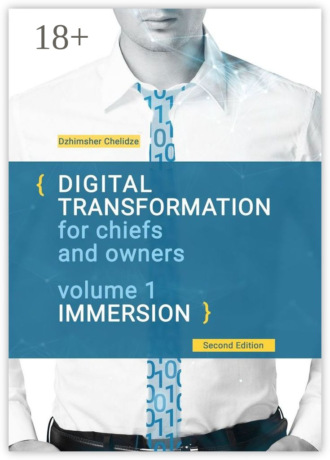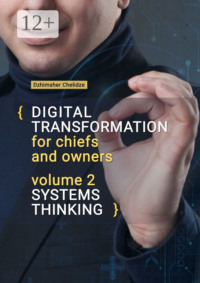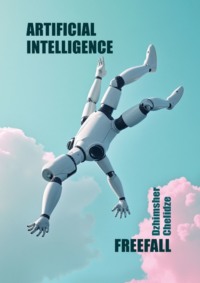
Полная версия
Digital Transformation for Chiefs and Owners. Volume 1. Immersion
Digital business
This is a strategic function, which was previously handled by the Director of development, but now the focus is moving to numbers, and 3 more areas have appeared:
– digitalization and business transformation;
– digital venture investments;
– digital laboratory.
Digitalization of business is a change in the business model and the introduction of technologies into the company’s processes. As a result, operating losses should decrease, and business profitability and revenue should increase.
Digital venture investments – search for new business niches and promising start-ups to invest in. Accordingly, the quality of investments in these niches is assessed.
The digital laboratory creates promising partnerships and organizes a factory of pilot projects. The indicators are the number and success of the pilot projects launched.
Within the direction of digitalization and business transformation, the following directions can be distinguished:
– IT infrastructure and its optimization;
– production, including maintenance and repairs, industrial safety, operational analytics, automation of reporting, etc.;
– logistics and logistics;
– organizational efficiency and record keeping;
– sales and current products/services, i.e. customer service;
– economics and finance, including accounting;
– frames.
Required roles in the digital transformation team
The following list is not a record in the employment record, but a list of the roles to be performed.
– CDTO (Chief Digital Transformation Officer, or Head of Digital Transformation).
The main ideologist, who chooses the goals and direction of the movement, agrees the budget and manages the implementation of the transformation, coordinating all projects, interacting with external parties and inspiring his team.
– CA (Chief Architector, or Chief Architect).
It is responsible for the practical implementation of transformation in the form of connecting all components: business processes, applications, data warehouses, interfaces of interaction. It is not desirable for one person to combine the roles of chief architect and project manager, as their roles and responsibilities in the project are very different. The project manager is primarily the manager and the chief architect is the technician.
– CDO (Chief Data Officer, or Data Manager).
Responsible for the timely provision of the necessary data and analytics, coordinates their collection, storage and processing, forms a data processing unit.
– CTO (Chief Transformation Officer, or Digital Design and Process Manager).
Responsible for the implementation of the process approach and the design of new digital services, the study of processes, needs and customers.
Also important:
– lawyer (monitors changes, innovations and nuances of legislation, especially in the field of intellectual and data rights);
– Specialist for Interaction with External Organizations (contacts with data owners used in the project);
– information security specialist (responsible for data protection, which inevitably attract increased interest immediately after informing the external environment). In general, you should not neglect information security. As soon as you become visible on the market, there are people who want to get your data. However, do not close, because most of your data loses its value with the speed of fading banana from the store.
At the same time, it is necessary to understand that the current CIO (the head of the IT direction) is not suitable for the post of CDTO. Or it will need a long-term overhaul of its thinking and work priorities. We will address this issue in more detail in one of the following chapters.
Digital marketing
This is a function for generating digital content and managing end-to-end communication through digital channels. The main tasks are:
– the production of digital content;
– brand management in digital space and communication channels (messengers, social networks, email, etc.);
– Interact with users to collect feedback and learn preferences;
– launch of advertising campaigns.
The main roles here are:
– SMM specialist;
– MarTech specialist;
– Target Analyst;
– SEO specialist.
SMM-specialist is engaged in the promotion of business on the platforms of user content, i.e. in social networks, blogs, on educational platforms and in the framework of advertising campaigns.
MarTech specialist manages digital marketing technologies, i.e., tools that help plan, implement and automate the marketing activity of the company, measure its results and ensure continuous interaction with the audience. Now there are many tools that allow marketers to work with data and digitize routine processes.
The target scientist works with the target audience through targeted advertising.
The SEO specialist is responsible for transferring the traffic of Internet users to your resources (sites, applications).
Digital products
It’s about creating new digital products in the form of analytics services, applications.
How digital products differ from «classic»:
• communication between the user and the seller is direct, through digital channels;
• The processes involved in providing the service use modern tools – digital platforms, chat bots, machine learning, big data and the like.
The following key roles are required in this area.
1. Product Manager / Product Owner (more correctly «Product Manager») is an entrepreneur within the company who manages the product, forms requirements for it, negotiates with partners, manages its profit. It’s a key role for a digital product.
The product manager must have the following skills.
– Knowledge of psychology, market laws and subject matter
In order to create something, you need to understand the market and see its trends. This gives the ability to generate ideas and form hypotheses from them.
– Creative thinking
The ability to create is a very rare quality associated with going beyond the usual limits. Creative thinking improves the quality and quantity of ideas.
– Understanding Customer Needs
It’s not about what you’re interested in, it’s about what solves your client’s problems. This guarantees a public response, which means that the product will be used more often.
– Knowledge of IT
You can’t come up with a product without knowing what technology it’s going to be made with. Already at the stage of the project you need to know its future prospects and opportunities (transformation, expansion, integration).
– Ability to cooperate
One in a field is not a warrior. Although it often happens in startups that the product manager works as a marketer, developer, and salesman, but in the first place he is the organizer, which means he needs to be able to work in a team. In addition, it is important to build cooperation with other teams and companies. As the practice in the B2B market shows, the end customer wants to receive a comprehensive product, and the more technical partners, worked out system integrations, the higher the chance of success. Again, as practice has shown, relying on system integrators is very risky.
– Knowledge of basic product management tools and data analysis skills
No matter how smart you are, you need to own tools and be able to analyze data. It is not enough just to see data. Practice confirms that most companies suffer from neglect of analytics. Those who do not make the same mistake make better and more informed decisions.
2. UX/UI is a specialist who focuses on the development of a convenient digital product that will be comfortable and enjoyable for the customer. It manages the interfaces of your sites, applications, services: their logic, fonts, colors and so on.
One of the key competences here – knowledge of the principles of lean production. That is, the ability to organize the product interface so that the user does not have to make unnecessary moves.
Digital analytics
This is the collection and systematization of data from all channels and sources. What is known as Big Data, or big data? What it is, we will figure out later, but what kind of people are needed, is already clear. These are different analysts. Additionally, although it seems that they are all engaged in the same, they are distinguished by «specialization».
In general, they’re all data analysts. However, there are, for example, data scientists who are engaged in «science» and form mathematical models necessary for better design. The main direction of such a specialist is to predict and form new hypotheses.
Classical data analysts perform slightly more understandable tasks: collect, process, study, visualize and interpret the collected data about events that have already occurred.
Digital production (industry 4.0)
Technology, sensors, robotics, and artificial intelligence are beginning to be used in production, and some of the solutions in the pipeline are no longer human, but machine-driven. Design initially takes place in a digital environment along with the creation of digital counterparts, which inevitably leads to the discovery of new roles.
– The CAD engineer creates prototypes directly in the digital environment. In order to start production and collect operational data from them. Such a person should deeply understand mathematics, engineering and digital tools.
– The Robotics Specialist (RPA) knows how to build software robots and understands application scenarios. This is a business analyst with programming skills. A little later, we’ll look at who RPAs are, what kinds they are, what effects they have.
– Process Analytics analyzes and works in BPM-solutions (business process simulation systems), to which we will also return. The main difficulty – a large number of rules and standards to describe business processes. At the same time, ordinary people understand them with difficulty. It was therefore necessary to strike a balance between detail and accessibility for staff. And it is better to make several descriptions – one detailed for analysts and several role-playing ones that fit on sheet A4.
– The computer vision and learning specialist helps machines «see» and distinguish objects, people, animals and the world around. The machine itself will not understand what it sees – it needs to be trained. Computer vision is one of the promising areas. We will consider it below.
New ways of working
It’s about how we work and think at work. New ways of thinking are not so much about Agile’s flexible methodology and different approaches based on it as about philosophy, about leaving decision-making for creative potential.
For example, these include the use of digital tools to organize work: kanban tables, knowledge management, exchange of ideas, organization of online meetings and hybrid graphics. Also, important here is the use of digital tools for seamless communication: calendar, mail, messengers, audio calls, video meetings, task trackers.
There’s one new role – evangelist, or agile coach. Its main task is to explain that it is possible to build business processes in a different way, to work more flexibly. In essence, it should educate the organization’s employees about digital lifestyles. The more people use digital tools, the more they will understand this culture. For example, there will be no need to meet in person if you can use the Zoom service or if you dislike many Teams.
New Types of Business Models
The number brings the ability to create new business models. Let’s look at them.
– Free model (special model)
For example, it uses on Google. It’s about monetization through embedded advertising. That is, such companies sell you, your attention and time, and analytics of your behavior.
– Subscription model
Instead of one large purchase you make a subscription to the service, that is, you include constant «invisible» payments.
We all know Netflix or Office 365. These products are examples of the classic subscription model. The user receives access, updates, services, etc. on a monthly/annual basis.
Plus, for the company – stable flow of money regardless of the season or other factors.
– Freemium-model
Users have free access to the basic (Free) version of the product, which is usually limited in the most valuable features. To use more features or resources, you must upgrade to a paid version (Premium).
An example is Spotify. Everyone can use the service for free (and receive advertising), but if you want more features and better quality, you need to pay for a monthly subscription. This is also a great example of how business models can be mixed.
Now it’s one of the most popular models. In the free version you can «sew» advertising and earn on it, and if the user does not want to receive it, then earn directly.
– Model on request
On-Demand works, for example, in online video stores, where you get the right to watch a movie for a certain period of time (Amazon Video, Apple TV+ and so on. d.).
The same system is used when you book a consultant and pay depending on how long you need help.
– E-commerce model
This is an example of trading platforms (Aliexpress, Amazon) or online stores. Today, it is also the best-known business model on the web, as you can buy almost anything online.
– Platform model (two-way marketplace)
The bilateral market is something that we see quite often on the Internet. Sellers and buyers use the third-party platform (Yandex Market, Ozon) to trade their goods and services.
The biggest problem with this business model is its complexity and dynamics. If you don’t have sellers, you’ll never attract buyers, and if you don’t have buyers, you’ll lose sellers. Thus, the bilateral platform should carefully scale demand and supply simultaneously to keep both sides attractive.
– Ecosystem model
Digital ecosystems are one of the most complex and powerful business models. A striking example is Apple. If you’re in the ecosystem, it’s gonna be hard to get out. Try switching from Android to iOS or back – this is not the easiest task for the ordinary person. However, inside the ecosystem you are comfortable, you get used to «single purse».
– Ownership Access Model/Sharing Model
This is the so-called «sharing economy». Such a system allows you to pay for a product, service or offer for a certain amount of time without obtaining real property rights. This can be a car rental (for example, Yandex Drive, Delimobile), apartment rental (for example, Airbnb) or even industrial machinery. An example of the latter is «Kamaz». As part of their digital transformation strategy, they launch short-term truck rental services. And this was made possible by the widespread use of digital technology.
This business model is one of the most revolutionary when one considers its impact on ownership and the resulting revenues. The car could suddenly become a source of income instead of just generating costs.
– Experience model
Adding experience to products that would not have been possible without digital technology. One example is Tesla, which has brought the automotive industry a whole new digital experience by adding digital services and even a digital ecosystem to its cars, which are now the main engine for their business model.
– Service Model
Here we talk about the fact that the user pays not for the product, but for the service. For example, the fertilizer producer does not supply the customer with fertilizer, but combines expertise and resources, providing services for the treatment of the area and increase of the crop.
He’s got big data that he’s learning to develop more efficient fertilizers, he’s got cheaper technology (economies of scale), more advanced logistics, and so on.
Or, for example, buying industrial equipment, you do not fill your head with questions of its maintenance. The manufacturer collects the data, analyzes it and organizes the service itself.
Preparing for digital transformation and digitization
Before you implement any changes, you need to understand what is now? What is your starting point? On this depends the whole further strategy.
The conscious construction of digital transformation involves, in one form or another, the following three steps:
1) definition of the «basic» situation, starting point;
2) target level definition (where do we want to go?);
3) planning actions to reach the target level.
In principle, as will be seen below, there is nothing new here, all this is combined with the basic methods of change implementation.
Digital maturity is the ability to use digital tools to achieve key performance, or more precisely, to shape a better value proposition for customers.
Among the various ways to measure the level of digital maturity I can distinguish the RANHiGS technique. It includes seven assessment areas and describes their maturity levels.
– Digital culture
The level of organizational culture supporting the processes of continuous improvement and innovation, change management.
– Frames
Compliance of personnel with competencies necessary for successful work in the digital economy.
– Processes
Application of process management practices: process optimization methods, lean production, design thinking. Process analysis, monitoring and continuous updating.
– Digital Products
Analysis of existing products and activities with them. The product is a solution to the user’s need, carrying value for the latter.
– Models
Use of information models in the organization, their constant updating, validity and inclusion in processes.
– Data
Access to the necessary data in real time with the necessary level of security. Completeness and quality of data for decision making.
– Infrastructure and tools
Access to modern digital infrastructure and ensure operation on all types of devices.
My focus in my work is more on:
– industry and company performance versus competitors;
– the use of modern technologies and work with data;
– working with operational processes, including their optimization;
– approach to project management and implementation of changes, creation of products;
– human Resources and current organizational development.
An example of my approach can be seen in the second book in the chapter on digitalization strategy.
Organizational changes in digitalization
For example, in my practice there was a case when the company changed its organizational structure three times. Smart plans came from Moscow, orders were issued, posts were renamed. However, did something change in the work on the ground? No!
Just the paper was one step further from life. Well, some were «optimized».
What kind of changes should digitalization and digital transformation lead to?
– Transition from complex hierarchical structures, that is, transition to 3—4 levels of management – from the general director to the master of the site.
– Review of policies, structure of units, number of staff and complexity of procedures.
That did not imply a reduction in staff, but a redeployment of staff to improve efficiency.
People must be sure of tomorrow. Only then will they accept the changes and be willing to share ideas.
– New roles, functions and needs for new competencies and skills emerge.
Currently, there are no employees who have all the necessary skills. And there are not even requirements for new roles. It is necessary to consider this.
– Change of organizational. culture – new approaches to personnel management, new system of values, withdrawal from management from the position of force and punishment, fines.
Transformational change will require more skilled human resources that are highly mobile and do not adopt outdated management models.
Here you will have to combine softness and discipline, to be able to fairly punish and manage employees depending on their level of «maturity». In my opinion, this is one of the key issues. We cannot go into anarchy or, on the contrary, into dictatorship. Which means you have to learn from the CEOs.
Skills are needed to manage staff using both financial and non-financial motivation. The use of financial motivation alone is very inefficient, has short-term effects and leads to stratification within the company.
Additionally, most importantly, you can’t change culture without changing the first people. If the Chief Engineer can’t use the IT system, but charges everything to 1—2 engineers and asks to print help – it’s just fiction and money in junk.
If you implement a complex asset management system to verify the execution of the budget, and all «opponents» just punish, then the approach to planning repairs from this will not change, but the turnover of personnel you provided.
In addition, it is necessary to actively work with external innovations, launch a large number of pilot projects. Why? Because it tells you that you’re willing to take risks and experience experiences, even negative ones. It’s important to be able to accept it, to analyze it, to learn, not to blame it. Then competences will be not only in the company’s reports and knowledge bases, but also in people.
Middle management must be actively involved in the change process. Many projects do not achieve their objectives at the level of middle and technical management. People are busy with their linear activities and do not know how to manage projects. As a result, we get combined resistance. Breaking this cycle is difficult, but necessary.
At least 30% of the people engaged in innovation have to undergo special training. This helps to form a common vision of where the organization is going, as well as to avoid conflicts and thoughts from the category «again something was invented above, now they will move and let’s go back».
Possible models of digitization and transformation
It is possible to digitize one of four models.
– Informal model
Someone at the company is doing the numbers for some reason. For example, the department of repair or maintenance began to implement digital tools and did it successfully. The downside is that the model does not cover the whole organization and the full potential of technology, but for many companies it becomes the starting point.
– Centralized model
The head of the organization or board of directors understands that digital technology and digitalization are very important for the company. They hire the CDTO, assign it a large unit, empower it – and it digitalizes the company.
The vast majority of companies in Russia are at this stage with an IT or Transformation Director at the head.
The advantage is that you can coordinate the movement and work of the whole organization.
Minus is the speed. The bigger the company, the more regulations, rules, restrictions, the more communication you need to conduct inside the company to launch a pilot project. After all, there is also resistance, as many leaders do not need this digitalization. As a result, companies invest in technology, and business customers simply ignore new tools, they impose them.
I participated in the project on this model and I can say that if the curator at the head of such a project does not have the necessary competencies, it can bury the whole project. Of course, in the reports everything will be shown beautifully – we can report like nowhere else. However, if you go down to the level of those who work «in the fields», you will understand how much money is wasted. The project in which I was involved, with a total budget of more than 1 billion rubles became my personal pain, forcing to learn from the mistakes of the curator. Additionally, communication with colleagues on the floor shows that such a model often only increases the time frame and budgets.
– Distributed model
Each division has its own digital office, which determines its own solutions and services.
In this case, the CDTO functionality is crushed and embedded into the existing structure so that these small offices start transforming their units from within. Then each division has its own «small» head or leader in numbers, and the big director of the number becomes unnecessary and leaves the company, because all can develop their own competencies. It’s a new culture.




